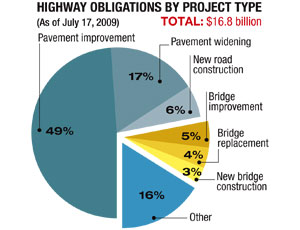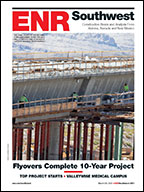State highway agencies have taken the term “shovel-ready” to heart, so far devoting nearly half of the American Recovery and Reinvestment Act dollars to pavement improvements, according to a recent report from the U.S Government Accountability Office.
That information has drawn a mixed response in Congress. House Transportation and Infrastructure Committee Chairman James Oberstar (D-Minn.) says the focus on such projects was expected. But Rep. John Mica (Fla.), the committee’s top Republican, wants to see more stimulus funds used for large projects.

In another stimulus development, the U.S. Dept. of Transportation’s Inspector General issued an Aug. 6 advisory, raising questions about some Federal Aviation Administration ARRA airport grants. But DOT Deputy Secretary John D. Porcari was quick to defend the grants.
Testifying before Oberstar’s committee on July 31, Katherine A. Siggerud, GAO’s managing director for physical infrastructure issues, reported that, as of July 17, $8.3 billion, or 49%, of the $16.8 billion in ARRA highway obligations, had gone for pavement improvements. Pavement widening accounted for another $2.8 billion, or 17%. Only $1.1 billion, or 6%, had been obligated for new road construction and another $1.2 billion, or 7%, for new bridge construction and bridge replacements.
Mica said he didn’t fault state agencies for picking “low-hanging fruit” by using stimulus aid for paving. But he added, “We have very few projects on the horizon of a large, significant nature that will employ people long-term....Unfortunately, the stimulus package is just leaving the big projects behind.”
Oberstar said there had been “hand-wringing” by economists that ARRA projects were “quick hitters,” but added that was expected. He said longer-term highway projects would be covered by the six-year surface transportation bill he has proposed.
Siggerud told the committee complicated projects will take longer to build. “That is why you see such a high percentage of repaving and rehabilitation because these are the projects that could be bid quickly and done during this construction season,” she said.
On the aviation front, DOT’s IG office reports “the economic merit of some FAA-approved [ARRA airport] projects may be subject to question and some projects may involve recipients with histories of grant management problems.” The IG cited six grant-winning projects that scored lower on FAA’s National Priority Rating system than the percentage goal the agency had set for priority ARRA consideration. The IG said the projects’ “economic merit—a key ARRA requirement—may be questionable.” Grants include $28.6 million to Akiachak and Ouzinkie, Alaska; as well as $9.9 million to Findlay Airport, Ohio; Wilbur Airport, Washington; Skyhaven Airport, Warrensburg, Mo.; and an airpark near Dover, Del.
“FAA carefully ensured that each grant issued using recovery-act funding fully complied with applicable statutory requirements,” DOT’s Porcari said.



Post a comment to this article
Report Abusive Comment